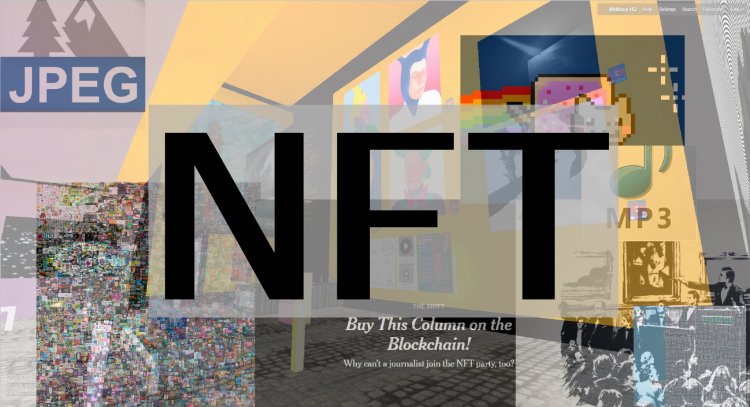A personal piece of public art: pictures, music, and posts published on social networks now have a place at auction. The very first tweet, published by Twitter CEO Jack Dorsey in March 2006 – “just setting up my twttr” – was bought for $2.9 million. A collage of 5,000 images that internet artist Mike Winkelmann, also known as Beeple, was posting online daily since 2007, went under the hammer for $69.3 million. A column from The New York Times went for $558,000: it’s a column titled Buy This Column on the Blockchain! And it was actually bought via blockchain: an article about non-fungible tokens – NFTs – was reclassified as an online asset for sale. We will explain how and why people pay millions for pictures, videos, and music that are publicly available on the Internet.
Unique tokens
Unique NFT is an abbreviation for non-fungible token: a token that is not interchangeable. It is a kind of asset in cryptocurrency wallets on blockchain platforms of certain electronic currencies.
Blockchain is a technology of distributed computing and decentralized storage of information. An unbroken chain of blocks of information: a list or database, cannot be deleted or edited, only expanded. The database is stored on computers connected to the platform. In order to make blockchain work and service transactions, it needs computing power, which is provided by network members – miners; without them, the database will not work. And for providing computing power, miners are rewarded with cryptocurrency, which is stored in cryptocurrency wallets.
Tokens are also stored in the same place – blockchain-based cryptocurrency wallets. Unlike electronic coins, tokens are not pure cryptocurrency, but rather digitized assets with a value determined by whoever issued them. For example, one token can be equal to one share of a company. Initially, all these tokens are held in the hands of the company that issued them, but over time they can be exchanged under certain conditions. In other words, a token is an electronic certificate that electronically confirms ownership of an asset, sometimes even a real asset.
Most tokens are fungible – let’s say, you borrowed a thousand rubles in one banknote. Repaying the debt with a thousand rubles banknote, even if it is a different one, will not confuse anyone – banknotes of the same denomination are absolutely identical – these are fungible tokens.
NFTs are non-fungible tokens, they are unique and unrelated in value. For example, objects of electronic art – music, paintings, or even Internet memes: the Nyan Cat was sold at a digital art auction for $590,000. This does not mean that the GIF with the cat flying on the rainbow will be removed from the entire Internet and the image will be only available to one person. The picture is still available and can be viewed or downloaded. But the moment the author tokenized the image, it became the original. Let’s take Malevich’s Black Square as an example. There are millions of copies in the world, but the original hangs in the Tretyakov Gallery. It is the same with tokenized images – the author creates a digital picture, converts it into NFT and sells this token – so, the buyer becomes the owner of the original, and the more popular the copy on the Internet is, the more valuable is the main asset. In other words, NFT is a certificate of ownership in virtual space.
Relative Ownership
The market for digital values – both currency and other assets – is only getting stronger in the world. Bitcoin is only 12 years old and non-fungible tokens are only 4 years old – the technology was invented in 2017. There is no unified legal framework for the circulation of virtual values. In Russia, for example, the purchase of NFT will give absolutely no rights to the purchased asset. This completely new object for the legislation does not fall into any of the regulatory lists, which means that, having spent the money, you will only be proud that this particular Internet picture belongs to you. The rest of the Internet, however, will not have a clue about it, if its users do not check the NFT on special sites.
In the USA, you can claim your rights after the purchase of NFT, but only if it was stipulated by specific conditions. If the NFT description doesn’t say anything about licenses, then the buyer won’t get any rights, which means you can’t buy a popular picture on the Internet and start mass production of T-shirts with prints – the image creator will win the copyright court.
So, without any additional conditions or contracts, people buy tokens alone. Developers plan to introduce different types of licenses on the platforms where NFTs are sold – when creating a token, the author will be able to choose the license he sells Internet art under: whether it’s exclusive rights or just the fact of ownership. But this system will only operate in those countries where the cryptovalue market is somehow regulated by law.
Your own piece of the Internet
The creators of the Ethereum blockchain platform, where NFTs first appeared, claim that one day it will be possible to buy a car and get NFTs instead of documents on it.
So far, the authors of Internet art say that NFT, though not definitively, protects their copyrights. And those who want to support the authors can do it with a proven crypto scheme via a blockchain wallet. In the meantime, collectors create Internet galleries: some websites allow you to build your own virtual museum and hang NFT originals of pixel or vector art on digital walls.
And despite the legally dubious attitude to the cryptomarket in Russia, the State Hermitage Museum has announced that it will hold an exhibition of NFT art in 2021. The museum has not yet announced how it will organize it.
Illustration, collage: Alexandr Burmistrov, Scientific Russia






















